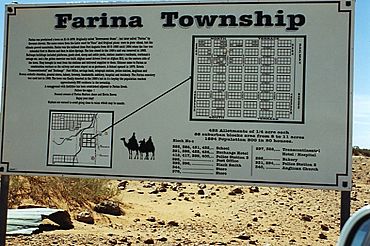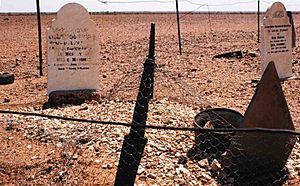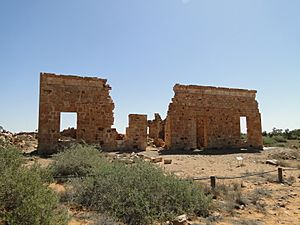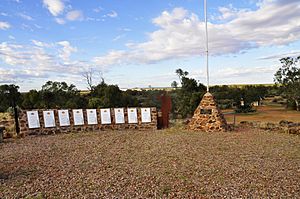Farina, South Australia facts for kids
Quick facts for kids FarinaSouth Australia |
|||||||||||||||
|---|---|---|---|---|---|---|---|---|---|---|---|---|---|---|---|

Farina Sign
|
|||||||||||||||
| Population | 15 (includes other localities in the "State Suburb of Farina") (2021 census) | ||||||||||||||
| Established | 21 March 1878 (town) 29 May 1997 (locality) |
||||||||||||||
| Postcode(s) | 5733 | ||||||||||||||
| Elevation | 303 m (994 ft) | ||||||||||||||
| Time zone | ACST (UTC+9:30) | ||||||||||||||
| • Summer (DST) | ACDT (UTC+10:30) | ||||||||||||||
| LGA(s) | Pastoral Unincorporated Area | ||||||||||||||
| Region | Far North | ||||||||||||||
| State electorate(s) | Stuart | ||||||||||||||
| Federal Division(s) | Grey | ||||||||||||||
|
|||||||||||||||
|
|||||||||||||||
| Footnotes | Adjoining localities | ||||||||||||||
Farina is a fascinating ghost town in South Australia. It was once called Farina Town and even Government Gums. The name Farina also refers to a larger area of about 8,500 square kilometres. In 2021, only 15 people lived in this wider area.
Farina is located in the very dry Lake Eyre basin. It's about 26 kilometres north of Lyndhurst. It's also 55 kilometres south of Marree. This is where the famous Oodnadatta Track and Birdsville Track begin. Farina is about 540 kilometres north of Adelaide, the state capital.
Contents
Farina's Story: A Ghost Town's Past
Farina was first settled in 1878. It was originally known as The Gums or Government Gums. Farmers moved here hoping that rain would follow their ploughs. This idea meant they thought farming would bring more rain.
For a while, Farina was the end of the railway line. This was before the tracks were extended to Marree in 1884. During some wet years in the 1880s, people planned a big town. They thought it would be great for growing crops like wheat and barley. However, the area usually doesn't get enough rain for these crops.
What Farina Was Like
Farina grew quite a lot. At its busiest, about 600 people lived there. The town had two hotels, a special underground bakery, and a bank. There were also two breweries, a general store, and a church. Five blacksmiths worked in town, and there was a school. In 1909, a large iron meteorite was found near Farina. It weighed 1,143 kilograms!
Today, only stone ruins and the old railway water tank remain. The post office closed in the 1960s. The railway line stopped operating in the 1980s. No one lives in the town itself anymore. The closest residents are at Farina Station, a nearby property.
Bringing Farina Back to Life
A group called the Farina Restoration Group started in 2008. Volunteers work to restore parts of the old town. In 2009, 30 people spent two weeks helping. They have fixed up the old bakery. They also added signs to explain the town's history.
Farina's Cemeteries
Farina has a cemetery a few kilometres away. You can find it by following a signposted track. One interesting part is the Afghan corner. It has headstones with both English and Arabic writing. Some headstones have no writing at all. These mark the graves of people from Afghanistan. They were involved with camel trains. These camel trains used to carry goods before the railway was built. All the gravestones face Mecca, which is important in the Islamic faith.
Farina and the World Wars
Farina played a part in both World War I and World War II.
World War I
During World War I, 33 men born in Farina joined the army. They were all volunteers. The first man joined in August 1914. The last man joined in March 1918.
Sadly, 5 of these men were killed in action. Ten others were wounded. One man died at sea while traveling to England. The last survivors from Farina were discharged in August 1920.
World War II
In World War II, 35 men from Farina enlisted. Nine of them served in the Royal Australian Air Force. The first man joined in October 1939. The last man joined in March 1945. The youngest was 18, and the oldest was 45.
Three men were killed in action during this war. A fourth man died while serving in the army. The last Farina man was discharged in October 1948.
Farina's Climate
Farina has a hot desert climate. This means it is very dry and hot. The weather station there stopped recording temperatures in 1939.
| Climate data for Farina 1889–1939 normals, rainfall 1879-2018 | |||||||||||||
|---|---|---|---|---|---|---|---|---|---|---|---|---|---|
| Month | Jan | Feb | Mar | Apr | May | Jun | Jul | Aug | Sep | Oct | Nov | Dec | Year |
| Record high °C (°F) | 46.7 (116.1) |
45.6 (114.1) |
43.3 (109.9) |
38.9 (102.0) |
33.1 (91.6) |
30.0 (86.0) |
30.0 (86.0) |
31.7 (89.1) |
37.8 (100.0) |
43.1 (109.6) |
44.2 (111.6) |
46.4 (115.5) |
46.7 (116.1) |
| Mean daily maximum °C (°F) | 35.5 (95.9) |
35.4 (95.7) |
32.0 (89.6) |
26.5 (79.7) |
21.6 (70.9) |
17.7 (63.9) |
17.3 (63.1) |
19.8 (67.6) |
23.7 (74.7) |
27.9 (82.2) |
31.9 (89.4) |
34.5 (94.1) |
27.0 (80.6) |
| Mean daily minimum °C (°F) | 19.9 (67.8) |
20.0 (68.0) |
17.0 (62.6) |
12.1 (53.8) |
8.1 (46.6) |
5.5 (41.9) |
4.1 (39.4) |
5.7 (42.3) |
8.5 (47.3) |
12.5 (54.5) |
16.1 (61.0) |
18.7 (65.7) |
12.4 (54.3) |
| Record low °C (°F) | 10.6 (51.1) |
10.6 (51.1) |
7.8 (46.0) |
2.7 (36.9) |
−1.4 (29.5) |
−2.8 (27.0) |
−3.8 (25.2) |
−2.2 (28.0) |
0.6 (33.1) |
2.8 (37.0) |
5.6 (42.1) |
7.8 (46.0) |
−3.8 (25.2) |
| Average precipitation mm (inches) | 18.8 (0.74) |
19.7 (0.78) |
15.2 (0.60) |
10.7 (0.42) |
14.7 (0.58) |
16.0 (0.63) |
9.3 (0.37) |
10.7 (0.42) |
10.6 (0.42) |
12.9 (0.51) |
12.3 (0.48) |
15.1 (0.59) |
165.0 (6.50) |





